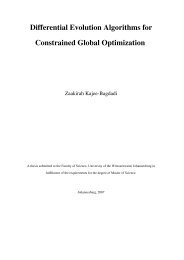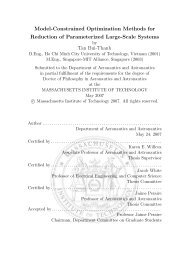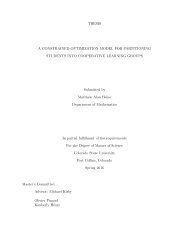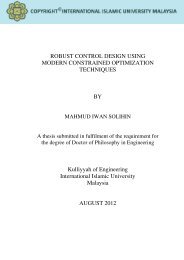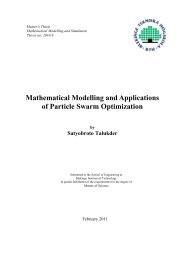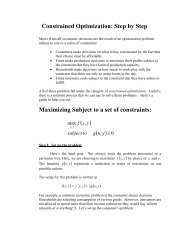Application of Genetic Algorithm in Multi-objective Optimization
Create successful ePaper yourself
Turn your PDF publications into a flip-book with our unique Google optimized e-Paper software.
(a)<br />
(b)<br />
Figure 3.2: (a) Balanced reactive forces with smaller enclosed area and (b) Bigger enclosed<br />
area with unbalanced reactive forces<br />
3.2. Develop<strong>in</strong>g the <strong>Genetic</strong> <strong>Algorithm</strong> Based Approach to Solve the Support<br />
Locations:<br />
After develop<strong>in</strong>g the test case, the next step was to develop the GA based optimization<br />
methodology. For solv<strong>in</strong>g the optimal support locations <strong>of</strong> the test case, a code was developed us<strong>in</strong>g<br />
GA. At that phase, the <strong>objective</strong> function, GA parameters, and various GA operators were<br />
determ<strong>in</strong>ed. While generat<strong>in</strong>g the <strong>objective</strong> function, the most critical challenge was to develop one<br />
s<strong>in</strong>gle <strong>objective</strong> function from multiple <strong>objective</strong>s. If the impact <strong>of</strong> each component <strong>of</strong> the <strong>objective</strong><br />
function on the optimal value was not treated properly, it could put more focus on a s<strong>in</strong>gle<br />
component and thus hamper the optimality <strong>of</strong> other elements. The primary challenge for this multi<strong>objective</strong><br />
optimization was to ensure the simultaneous convergence <strong>of</strong> all elements. Tak<strong>in</strong>g that <strong>in</strong>to<br />
consideration, the <strong>objective</strong> function was developed.<br />
46



